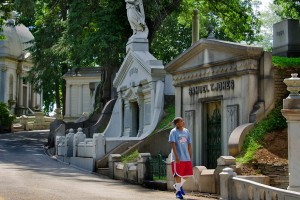Yellow Fever Couldn’t Keep Philadelphia Down
Imagine. It is a deadly summer in Philadelphia. Mosquitoes are biting everything. Neighbors are coughing up black vomit. They are dying in the streets. They are dying in their beds. The streets are clogged with carts of bodies and belongings. Those who can are leaving. You know who can’t. Church bells toll with each burial. For weeks, the bells toll constantly. Canons are being fired in the streets and muskets in homes. Some folks believe the gun smoke will drive away the infectious air. Down at Dock Creek, rotting animal carcasses are filling the basin as tanneries dump what remains after stripping off the skins. Some folks want to head down to the port and murder the newly arriving French who have escaped a slave revolt in the Caribbean. President George Washington, once a daily fixture on the streets, is long gone, as are all the so-called greats, the founders and leaders of a six-year-old nation. Tom Jefferson has been overheard saying he saw this coming. The rot, the corruption, the disease—all natural outgrowths of cities like London, like Philadelphia. Best they be abandoned in favor of the virtuous life of the farm and the frontier.
Somehow and without a clear reason, it ends. Cool breezes and the nip of frost seem to signal a different spring. But the census is overwhelming, devastating: 25,000 have fled; 13,000 contracted the disease they are calling Yellow Fever. More than 5,000 died, and that’s just the ones who were counted. They know it was more. Philadelphia has become a city of orphans, widows. There is little to eat. No safety net. Its people have been quarantined from entering other cities lest they carry it there. New Yorkers, already annoyed at Philadelphia and eying it as major competition, don’t lend a hand. They close their port to Philadelphia’s ships and their borders to its carriages. They are not alone.
This is the story that can’t happen. It is too devastating, too far out, too unbelievable to really occur. Except it did. Here. In Philadelphia. In 1793.
On Wednesday night, a partnership of History Making Productions (founded by me and Philip Katz) and WPVI-TV/6 ABC, will broadcast Fever 1793. The film has everything to make for a watchable TV show: production value, interesting experts, rarely seen imagery, death, disease and destruction. But it is also a story of Philadelphia grit.
There’s a back story of vicious debates, highly personal and demoralizing, among the great physicians of the time who disagreed about the cause of the disease. There’s bloodletting and mercury treatments, and just about every other aspect of the epidemic. There’s the fact that the raucousness of their fight established a tradition of medical research and discovery that survives in our city more than 200 years later.
The fever returned in the latter part of the 1790s and took another 5,000 lives. By any rational response, Philadelphia should have closed shop, boarded up. Fini.
Of course, that’s not what happened. Instead, a board of health was created to begin a novel initiative: street cleaning. A new quarantine hospital was built downriver (in Tinicum Township) where arriving cargo and sick immigrants could be screened. Penn’s five squares, long ago abandoned and lost, were reclaimed and made green to improve air quality. A waterworks was built at the site of City Hall to deliver fresh Schuylkill water to city residents using a steam pump.
(See more of our Philadelphia history webisodes here.)
When the dust settled, a city emerged. It is, in reality, the beginning of the American City, another Philadelphia first.
Fever 1793 will air on 6 ABC at 7:30 p.m. on April 4th.


